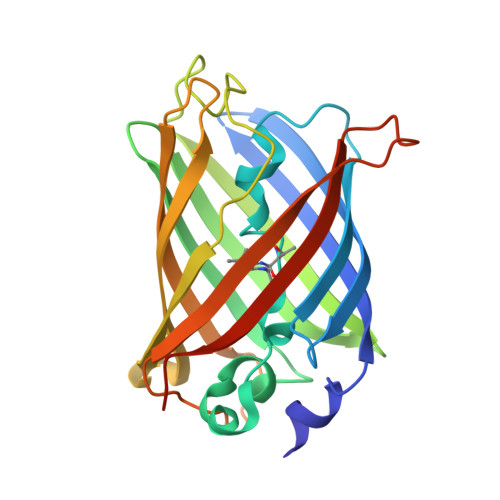The Crystal Structure of the Y66L Variant of Green Fluorescent Protein Supports a Cyclization-Oxidation-Dehydration Mechanism for Chromophore Maturation(,).
Rosenow, M.A., Huffman, H.A., Phail, M.E., Wachter, R.M.(2004) Biochemistry 43: 4464-4472
- PubMed: 15078092
- DOI: https://doi.org/10.1021/bi0361315
- Primary Citation of Related Structures:
1S6Z - PubMed Abstract:
The crystal structure of a colorless variant of green fluorescent protein (GFP) containing the Y66L substitution has been determined to 1.5 A. Crystallographic evidence is presented for the formation of a trapped intermediate on the pathway of chromophore maturation, where the peptide backbone of residues 65-67 has condensed to form a five-membered heterocyclic ring. The hydroxyl leaving group remains attached to the ring as confirmed by high-resolution electrospray mass spectrometry. The alpha-carbon of residue 66 exhibits trigonal planar geometry, consistent with ring oxidation by molecular oxygen. Side chain positions of surrounding residues are not perturbed, in contrast to structural results obtained for the GFPsol-S65G/Y66G variant [Barondeau, D. P., Putnam, C. D., Kassmann, C. J., Tainer, J. A., and Getzoff, E. D. (2003) Proc. Natl. Acad. Sci. U.S.A. 100, 12111-12116]. The data are in accord with a reaction pathway in which dehydration is the last of three chemical steps in GFP chromophore formation. A novel mechanism for chromophore biosynthesis is proposed: when the protein folds, the backbone condenses to form a cyclopentyl tetrahedral intermediate. In the second step, the ring is oxidized by molecular oxygen. In the third and final step, elimination of the hydroxyl leaving group as water is coupled to a proton transfer reaction that may proceed via hydrogen-bonded solvent molecules. Replacement of the aromatic Tyr66 with an aliphatic residue appears to have a profound effect on the efficiency of ring dehydration. The proposed mechanism has important implications for understanding the factors that limit the maturation rate of GFP.
Organizational Affiliation:
Department of Chemistry and Biochemistry, Arizona State University, Tempe, Arizona 85287-1604, USA.
















